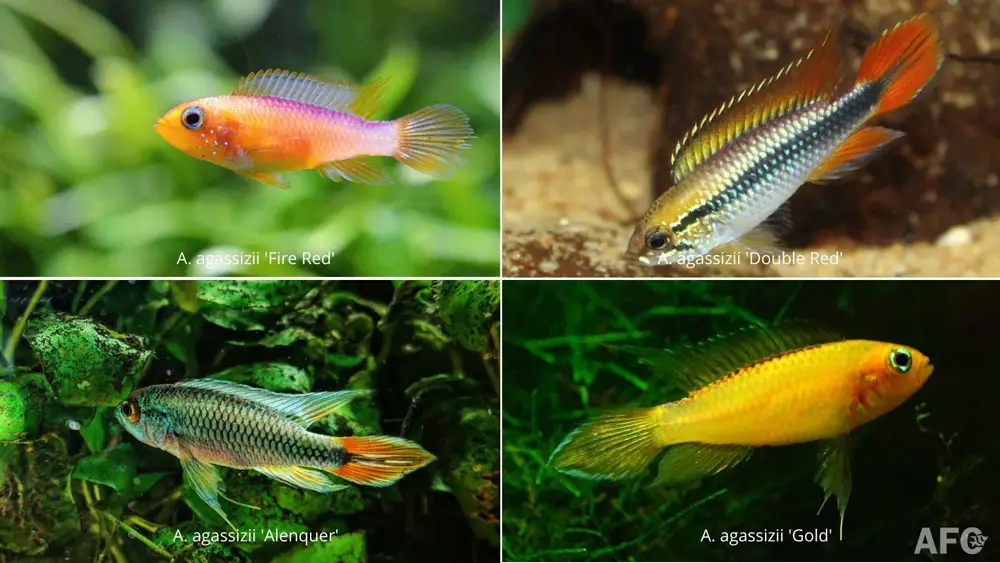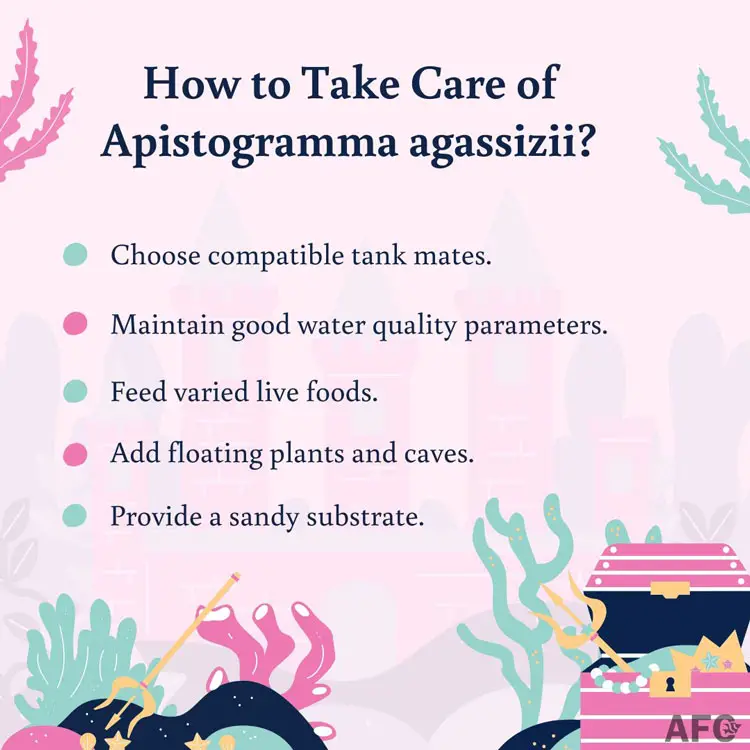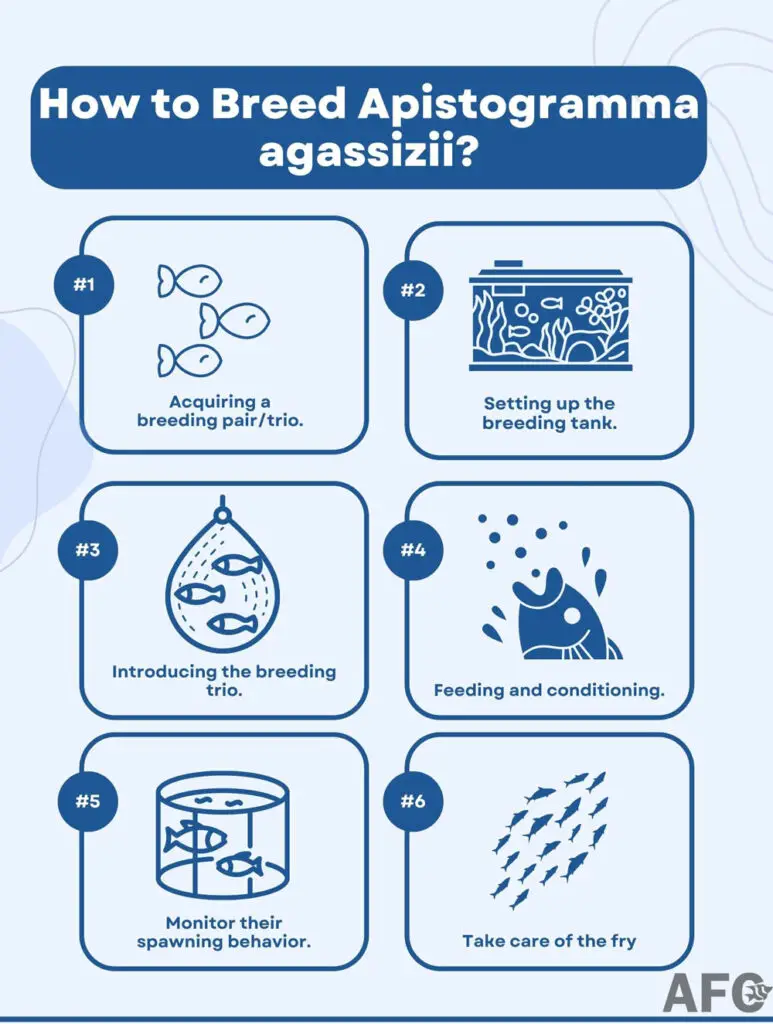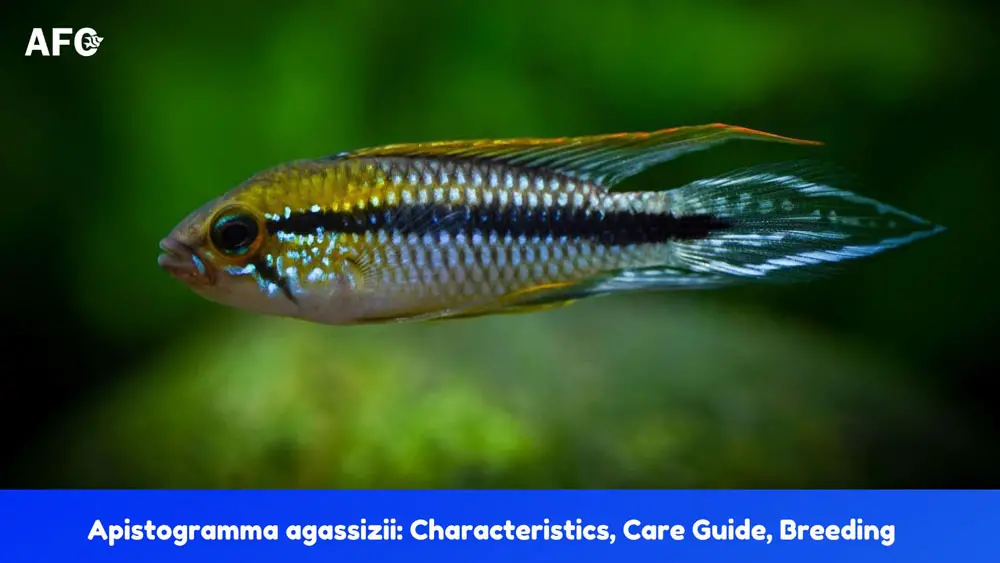Apistogramma agassizii, nicknamed affectionately Agassiz’s dwarf cichlid, is a colorful dwarf cichlid found in South America but is commonly kept in freshwater aquariums.
This Apistogramma species is prized by cichlid hobbyists for its varying color morphs, including red, blue, gold, and white. These sparkly and beautifully colored mutations of A. agassizii in the pet trade today are the result of selective breeding in captivity. Like most apistos, the difference between males and females is quite dramatic once fully mature.
While domestic strains are easy to take care of because they are disease-free and adaptable to a wide range of water parameters, however male A. agassizii can be aggressive towards females and other males during spawning. For this reason, this fish is not a good choice as a beginner Apistogramma dwarf cichlid.
Breeding Agassiz’s dwarf cichlid is relatively easy for intermediate aquarists who can provide specific water conditions and create a thriving environment, especially with wild-caught specimens.
Keep reading to learn all about these beautiful creatures that have captivated hobbyists for over a century, as well as the necessary care and breeding requirements.
What is Apistogramma agassizii?
Apistogramma agassizii is the scientific name for a small freshwater cichlid of the genus Apistogramma. It was first described in 1875 from fish collected by Professor J.L.R. Agassiz, for whom the species is named. In 1909, the first fish were imported into Germany, and they have remained popular ever since.
Due to its distinct geographical distributions, some authors and researchers of Apistogramma speculate that A. agassizii is a “superspecies” composed of several closely related “subspecies” rather than a single species.
A. agassizii is one of the few Apistos that can be easily identified. Compared to other Apistogramma, these fish have an elongated, laterally flattened body with a pronounced spade-shaped caudal tail. Their dorsal fins also tend to be a bit lower than other species. Males may also possess a small metallic blue patch on the corners of their mouths.
Today, many colorful strains of A. agassizii are readily available through selective breeding.
What Are the Most Popular Apistogramma agassizii Varieties?
These are the most popular Apistogramma agassizii varieties.
- Apistogramma agassizii ‘Fire Red’
- Apistogramma agassizii ‘Double Red’
- Apistogramma agassizii ‘Blue Flame”
- Apistogramma agassizii ‘Alenquer’
- Apistogramma agassizii ‘Super Red’
- Apistogramma agassizii ‘Tefe’
- Apistogramma agassizii ‘Fire Gold’
- Apistogramma agassizii ‘Santarem’
- Apistogramma agassizii ‘White Seam’
Apistogramma agassizii ‘Fire Red’
A. agassizii ‘Fire Red’ is a highly sought-after color variant of the Apistogramma agassizii species. It is visually striking, with a pale yellow body and vibrant red fins.
Apistogramma agassizii ‘Double Red’
A. agassizii ‘Double Red’ is a reddish variety of Agassiz’s Dwarf Cichlid. The term “Double Red” describes the bright red color found on the dorsal and caudal fin of this fish.
Apistogramma agassizii ‘Blue Flame’
A. agassizii ‘Blue Flame’ is a blue-colored mutation of the A. agassizii species. It is also sold as A. agassizii ‘Neon Blue’ or A. agassizii ‘Steel Blue.’ As its name suggests, this variety is characterized by its brilliant electric-blue coloration on the head, body, and dorsal fin.
Apistogramma agassizii ‘Alenquer’
A. agassizii ‘Alenquer’ is an uncommon, naturally occurring form of the A. agassizii superspecies, which is native to the clear waters around the town of Alenquer in the northern region of Brazil.
Males look spectacular with a pinecone-like pattern on their bodies and long extensions on the dorsal, anal, and caudal fins.
Apistogramma agassizii ‘Super Red’
A. agassizii ‘Super Red’ is a man-made variety of the A. agassizii species. This type has an even more intense red coloration on both the body and all fins, different from the ‘Double Red’ variety.
Apistogramma cf. agassizii ‘Tefe’
Apistogramma cf. agassizii ‘Tefe’ is considered a natural color variant of the A. agassizii superspecies among aquarium enthusiasts. It is known to come from the Tefé River, a tributary of the Amazon River in Amazonas state, north-western Brazil.
Males exhibit blue-pearl and yellow coloration on the gill cover, lateral line, and tips of the tail fin. This species looks similar to its closely related species, Apistogramma sp. ‘Tefe,’ which also inhabits the same river. However, the latter is distinguished by a dark zigzag stripe that runs along its lateral line.
Apistogramma agassizii ‘Fire Gold’
A. agassizii ‘Fire Gold’ is a relatively new artificially created form of Agassiz’s cichlid. It is most recognizable for its brilliant gold body with deep red flecks covering the upper third, giving it the appearance of a flame, from which it derives its name.
Apistogramma agassizii ‘Santarem’
A. agassizii ‘Santarem’ is a rare, wild type of A. agassizii species that originates from the area near Santarém, Brazil. It has a shiny metallic silver body with a bold black stripe running down the body, accented by deep red or orange from the eyes to the mid-back.
Apistogramma agassizii ‘White Seam’
The name “White Seam” refers to a color variation of Apistogramma agassizii characterized by shining white reflective scales along its sides and a stunning white rim around the tail. This rim shines like a spotlight in the aquarium, making the fish even more eye-catching.

What Are The Differences Between Male and Female Apistogramma agassizii?
The differences between males and females of the Apistogramma agassizii species are that adult males tend to be larger and more brightly colored than females. They can also be identified by their pronounced spade-shaped caudal fin, which is often edged in black on the outside margin. Females tend to be smaller and tan or yellow in color, with a rounder, plain dorsal fin.
How Big do Apistogramma agassizii Get?
Apistogramma agassizii is a small-sized apisto that grows to a maximum standard length of about 1.65 inches (4.2 cm), which is the length of the fish excluding the caudal fin. Their total length does not exceed 1.97 inches (5 cm), according to the Check List of the Freshwater Fishes of South and Central America hardcover by Sven O. Kullander and Roberto E. Reis.
Are Apistogramma agassizii Aggressive?
Yes, Apistogramma agassizii is an aggressive Apistogramma species because the males have a highly polygynous mating system, where one male mates with several females in his territory. They will become overly aggressive towards females who are not ready to spawn.
Female Agassiz’s dwarf cichlids can also be aggressive towards each other, and brooding females often chase or attack the male who tries to spawn again.
Despite their small size, polygamous Apistogramma species are commonly kept in a small group, known as a “harem,” with one male and several females.
What Is The Minimum Tank Size For Apistogramma agassizii?
The minimum tank size for a small group or a trio of Apistogramma agassizii is 20 gallons Long (75 liters). However, like most Apistogramma, they do best in larger groups of at least 3 males with 4-6 females. This helps to reduce aggression and allows you to observe their natural behavior.
When choosing a tank for Apistogramma agassizii, it is important to look for one with a wide footprint, which will give the fish more bottom area to establish their territories.
How Long Does Apistogramma agassizii Live?
The average lifespan of Apistogramma agassizii is two years, according to a 1991 statistical study by Dr. Uwe Römer. It is uncommon for them to live longer than five years.
Their lifespan can vary depending on many factors, such as genetics, diet, water quality, stress levels, and other environmental conditions.
What is The Native Habitat of Apistogramma agassizii?
Apistogramma agassizii originates from slow-moving, clearwater, and blackwater streams, lakes, and pools throughout the western Amazon basin, ranging from the tributary Tigre River in the Río Marañón system to the Río Ucayali in Peru and the lower Solimões River in Brazil. They live in groups in areas teeming with plant life and thick piles of leaves and brush.
How to Take Care of Apistogramma agassizii?
Here are some basic aspects of how to care for Agassiz’s dwarf cichlids in a home aquarium.
- Choose compatible tank mates
- Maintain good water quality parameters
- Feed varied live foods
- Add floating plants and caves
- Provide a sandy substrate
Tank-raised Agassiz’s dwarf cichlids are unfussy and quite hardy compared to wild-caught specimens, but they still require well-decorated tanks and soft, acidic water to thrive.
These fish are generally recommended to aquarists with experience due to their desired water conditions and aggressive behavior.
What Are the Good Tank Mates for Apistogramma agassizii?
These are some of the best tank mates for A. agassizii.
- Freshwater Angelfish
- Black Neon Tetra
- Cardinal Tetra
- Neon Tetra
- Green Neon Tetra
- Hatchetfish
- Pencilfish
- Rasboras
- Cory catfish
- Otos
A. agassizii are territorial bottom dwellers, so it can be problematic to introduce species that occupy the lower sections of the aquarium and will disturb the bottom territory.
When it comes to tankmates for the Agassiz’s dwarf cichlid, fishes that move between the middle and top of the tank and share similar water chemistry requirements will cohabitate with them well.
The perfect Apisto tank companions, as described by Al DeAngelo (1991), are a large group of surface-oriented fish, such as small South American tetras, hatchetfish, pencilfish, and rasboras.
Can Apistogramma agassizii Live With Geophagus?
Yes, A. agassizii can live with Geophagus cichlids, but only in tanks that are at least 125 (473 L) at a minimum.
These two closely related species have similar temperaments and sand-sifting behaviors, which can lead to territorial disputes. To reduce the risk of conflict, it is important to provide plenty of hiding places and to monitor the fish closely for signs of aggression.
Can You Keep Apistogramma agassizii with Ram Cichlids?
Yes, you can keep Apistogramma agassizii with German Blue Ram cichlids or Bolivian Ram cichlids, but be aware that the high water temperatures that Ram cichlids prefer can increase the metabolism of A. agassizii and shorten their lifespan.
Ram cichlids do best in temperatures around 84-86°F (29-30°C), while Apistogramma agassizii prefers cooler water temperatures, ideally between 79-84°F (26-29°C).
Will Apistogramma agassizii Eat Shrimp?
Yes, Apistogramma agassizii will eat shrimps that are too small to fit in their mouth. Large shrimps like Amanos would be safer to keep with these smaller Apistos.
What Are Optimum Water Parameters for Apistogramma agassizii?
According to Wolfgang Staeck’s hardcover book, “South American Dwarf Cichlids,” the optimum water quality parameters for Apistogramma agassizii are as follows.
- Temperature: 79 to 84°F (26 to 29°C)
- pH: 4.3 to 6.8
- Hardness: <1º dGH
- Conductivity: 5 to 10 ppm
These values represent the water chemistry found in their collecting sites. Because of their very extensive distributional range, Apistogramma agassizii has adapted to various water conditions.
Can Apistogramma agassizii Live in Hard Water?
Yes, captive-bred A. agassizii can acclimatize to hard water with a GH between 12 – 18 dGH (or 210 – 320 ppm), but they will not breed at all in such conditions.
Therefore, it is recommended to stick to the water parameters for their natural habitat (mentioned above) in order to optimize breeding success and help them flourish.
What Do Apistogramma agassizii Eat?
In their natural environment, A. agassizii eats insects, invertebrates, plant matter, algae, and worms.
In captivity, you can feed them a healthy variety of live food. Brine shrimp and daphnia that provide good roughage with their exoskeletons and a high protein and fat diet of bloodworms, glassworms, and mosquito larvae are good food choices.
Live tubifex and blackworms should be avoided because they often inhabit highly polluted water and can lead to water quality problems.
Aquarium-raised specimens are normally trained to accept commercial fish foods. To bring out their vivid colors, feed them a wide variety of foods.
How Often Should You Feed Apistogramma agassizii?
You should feed A. agassizii as much as they will eat in 2-3 minutes each feeding, twice a day.
Do Apistogramma agassizii Need Plants?
Agassiz’s dwarf cichlids need plants, particularly floating plants, to mimic their natural habitat and keep harsh light at bay.
What Substrate is Best for Apistogramma agassizii?
A fine, smooth, sandy substrate is the best option for Apistogramma agassizii because of its specific sand-sifting feeding behavior. Avoid using substrates that contain sharp edges particles, as they can potentially injure their delicate gills.
Moreover, consider adding plenty of leaf litter to the substrate, which serves as excellent hiding spots and food sources for the fry.

How to Breed Apistogramma agassizii?
Here is a step-by-step guide on breeding Apistogramma agassizii in a home aquarium.
Step 1: Acquiring a breeding pair/trio.
Start by acquiring a breeding pair or trio of Apistogramma agassizii from reputable online sellers like Aquaticclarity, Dan’s Fish, The Wet Spot Tropical Fish, and Aquaticarts. A trio is preferred because a male will continually harass a single female.
If you’re serious about breeding this species, start your breeding project with at least a half dozen young specimens and allow them to pair off. The more individuals you start with, the higher your chances of success.
Step 2: Setting up the breeding tank.
Set up a separate 20-gallon (long) aquarium for breeding A. agassizii. You should be intent upon emulating natural settings found in the wild as closely as possible, especially concerning water chemistry and environment.
Both Carbonate Hardness (KH) and General Hardness (GH) should be less than 50 ppm with slightly soft water at a pH of 6.5. If you’re trying to breed wild-caught specimens, you may need to reduce the pH to 6 or below. The ideal water temperature for breeding is around 79 °F (26 ºC). Lower or higher temperatures can affect the sex ratio of the fry. Perfect water conditions can be achieved using a reverse osmosis deionized (RO/DI) water system with peat moss added.
Mimic their natural environment by providing a fine sandy substrate, plenty of driftwood, leaf litter, and plenty of caves formed of clay flower pots, plastic tubes, or overturned coconut shells. Also, add some floating plants to keep harsh light at bay. Fry-safe dither fish like hatchetfish and pencilfish be used to change the dynamics of the tank and encourage Apistos to spawn.
Step 3: Introducing the breeding trio.
After setting up your tank, you should introduce them to the new environment. Give them enough time to settle in and establish their own territory.
Generally, the male will consider the entire tank as his territory, in which each female will have her own smaller territory.
Step 4: Feeding and conditioning.
Once your Apistogramma agassizii are settled in, you should start to condition them by feeding them live foods, such as daphnia and mosquito larvae, before the spawning attempt.
Step 5: Monitor their spawning behavior
Like any Apistogramma, the female will initiate courtship activities near her spawning cave. You may see the male beating the tail in response to the female.
Spawning will occur secretly in the cave. About 50 – 75 eggs are laid at a time and adhere to the ceiling of the cave. The female will become extremely protective in guarding the eggs and fry and may even attack the male when he gets too close.
It is common to see the female digging, building a huge sand pile in front of the cave entrance.
Step 6: Take care of the fry
The eggs hatch after 3-4 days, and the fry becomes free-swimming in about 5-7 days.
They are very small and should be fed live infusoria or rotifers for two weeks until they can accept newly hatched brine shrimp. Do water changes of 10% to 30% daily, depending on the fry size.
Are Apistogramma agassizii Easy to Breed?
No, Apistogramma agassizii are not easy to breed due to their specific water requirements and spawning behavior. They require a close replica of their natural habitat in order to be successful, so very acidic, soft water and a comfortable environment are essential.
What Apistogramma Can Reproduce in Harder Water?
Apistogramma cacatuoides, no matter whether it’s wild-caught or captive-bred, is one Apistogramma fish that can successfully reproduce and thrive in moderately hard water with a GH of 8-12 dGH (140-210 ppm).

Where to Buy Apistogramma agassizii?
There are many places you can buy Apistogramma agassizii.
- Local fish stores often sell popular domestic strains.
- Online retailers like Aqua Imports, The Wet Spot Tropical Fish, Live Aquaria, and Imperial Tropicals have many rare color varieties.
- Specialized breeders include Aquaticclarity, JDAquatics, Dan’s Fish, and Tristan’s Tropical Fish are trusted sources for wild-caught specimens.
- Individual breeders also offer wild-type fish and more unusual strains. You can find them on The Band app, Apistogramma Forum, and Aquabid.
